#Expert Data Annotation
Explore tagged Tumblr posts
Text
Generative AI | High-Quality Human Expert Labeling | Apex Data Sciences
Apex Data Sciences combines cutting-edge generative AI with RLHF for superior data labeling solutions. Get high-quality labeled data for your AI projects.
#GenerativeAI#AIDataLabeling#HumanExpertLabeling#High-Quality Data Labeling#Apex Data Sciences#Machine Learning Data Annotation#AI Training Data#Data Labeling Services#Expert Data Annotation#Quality AI Data#Generative AI Data Labeling Services#High-Quality Human Expert Data Labeling#Best AI Data Annotation Companies#Reliable Data Labeling for Machine Learning#AI Training Data Labeling Experts#Accurate Data Labeling for AI#Professional Data Annotation Services#Custom Data Labeling Solutions#Data Labeling for AI and ML#Apex Data Sciences Labeling Services
1 note
·
View note
Text
AI & Tech-Related Jobs Anyone Could Do
Here’s a list of 40 jobs or tasks related to AI and technology that almost anyone could potentially do, especially with basic training or the right resources:
Data Labeling/Annotation
AI Model Training Assistant
Chatbot Content Writer
AI Testing Assistant
Basic Data Entry for AI Models
AI Customer Service Representative
Social Media Content Curation (using AI tools)
Voice Assistant Testing
AI-Generated Content Editor
Image Captioning for AI Models
Transcription Services for AI Audio
Survey Creation for AI Training
Review and Reporting of AI Output
Content Moderator for AI Systems
Training Data Curator
Video and Image Data Tagging
Personal Assistant for AI Research Teams
AI Platform Support (user-facing)
Keyword Research for AI Algorithms
Marketing Campaign Optimization (AI tools)
AI Chatbot Script Tester
Simple Data Cleansing Tasks
Assisting with AI User Experience Research
Uploading Training Data to Cloud Platforms
Data Backup and Organization for AI Projects
Online Survey Administration for AI Data
Virtual Assistant (AI-powered tools)
Basic App Testing for AI Features
Content Creation for AI-based Tools
AI-Generated Design Testing (web design, logos)
Product Review and Feedback for AI Products
Organizing AI Training Sessions for Users
Data Privacy and Compliance Assistant
AI-Powered E-commerce Support (product recommendations)
AI Algorithm Performance Monitoring (basic tasks)
AI Project Documentation Assistant
Simple Customer Feedback Analysis (AI tools)
Video Subtitling for AI Translation Systems
AI-Enhanced SEO Optimization
Basic Tech Support for AI Tools
These roles or tasks could be done with minimal technical expertise, though many would benefit from basic training in AI tools or specific software used in these jobs. Some tasks might also involve working with AI platforms that automate parts of the process, making it easier for non-experts to participate.
3 notes
·
View notes
Text
Balancing Research and Conservation in Botanical Collections
Balancing Research and Conservation in Botanical Collections https://ift.tt/U7xQNhG Sometimes the most useful ways of getting information from herbarium specimens involves destroying part of them. How can this be balanced with stewardship of collections? Davis and colleagues from Missouri, Kew and New York botanical gardens have published a set of guidelines that balance aims to safeguard plant collections for future generations with contemporary research. The authors say that fewer than 0.5% of herbarium specimens have been destructively sampled. However, they also point to a sharp increase since 1988, when DNA sequencing started to take off. This, they argue, creates pressure on herbarium resources and staff who both want to make samples available for research but also preserve specimens for the future. They make the following recommendations: For Herbarium Users: Confirm specimen determinations before sampling Always consult other available resources before destructively sampling herbarium specimens Complement herbarium-based studies with fieldwork Ensure that institutional permission to destructively sample specimens is granted Prioritize destructive sampling of more recent collections Destructively sample only the amount of tissue required for the specific research Apply effective and proven methods Annotate specimens after sampling Make data from destructive sampling publicly available immediately Respect, collaborate with, support and appropriately credit herbarium stewards, taxonomic experts and herbaria For Herbarium Stewards: Evaluate individually each request for destructive sampling Destructive sampling of bioculturally sensitive plants requires special considerations Destructive sampling requests should balance current and future needs Treat destructive multiomics samples from collections as loans Develop a succession plan for derivative (for example, multiomics) collections from destructive sampling Protect against hoarding Ensure proper institutional permitting is up to date and available for inspection Destructive sampling should coincide with barcoding and specimen digitization Maintain thorough records and hold users accountable Establish transparent policies for destructive sampling and treat them as living documents Coming at this from an archaeological background, I’m particularly drawn to the guideline for users, Make data from destructive sampling publicly available immediately, which considers even a 1 year embargo on information exceptional. Given the potential to simply destroy information through lack of publication, this seems crucial for science. I hope the guideline for stewards, Maintain thorough records and hold users accountable, helps enforce this. It might be a problem if the steward and the user are the same person. Davis, C. C., Sessa, E., Paton, A., Antonelli, A., & Teisher, J. K. 2024. Guidelines for the effective and ethical sampling of herbaria. Nature Ecology & Evolution. https://doi.org/10.1038/s41559-024-02544-z ($) ReadCube: https://rdcu.be/dVMNZ Cross-posted to Bluesky, Mastodon & Threads. The post Balancing Research and Conservation in Botanical Collections appeared first on Botany One. via Botany One https://botany.one/ October 02, 2024 at 08:30PM
2 notes
·
View notes
Text
To some extent, the significance of humans’ AI ratings is evident in the money pouring into them. One company that hires people to do RLHF and data annotation was valued at more than $7 billion in 2021, and its CEO recently predicted that AI companies will soon spend billions of dollars on RLHF, similar to their investment in computing power. The global market for labeling data used to train these models (such as tagging an image of a cat with the label “cat”), another part of the “ghost work” powering AI, could reach nearly $14 billion by 2030, according to an estimate from April 2022, months before the ChatGPT gold rush began.
All of that money, however, rarely seems to be reaching the actual people doing the ghostly labor. The contours of the work are starting to materialize, and the few public investigations into it are alarming: Workers in Africa are paid as little as $1.50 an hour to check outputs for disturbing content that has reportedly left some of them with PTSD. Some contractors in the U.S. can earn only a couple of dollars above the minimum wage for repetitive, exhausting, and rudderless work. The pattern is similar to that of social-media content moderators, who can be paid a tenth as much as software engineers to scan traumatic content for hours every day. “The poor working conditions directly impact data quality,” Krystal Kauffman, a fellow at the Distributed AI Research Institute and an organizer of raters and data labelers on Amazon Mechanical Turk, a crowdsourcing platform, told me.
Stress, low pay, minimal instructions, inconsistent tasks, and tight deadlines—the sheer volume of data needed to train AI models almost necessitates a rush job—are a recipe for human error, according to Appen raters affiliated with the Alphabet Workers Union-Communications Workers of America and multiple independent experts. Documents obtained by Bloomberg, for instance, show that AI raters at Google have as little as three minutes to complete some tasks, and that they evaluate high-stakes responses, such as how to safely dose medication. Even OpenAI has written, in the technical report accompanying GPT-4, that “undesired behaviors [in AI systems] can arise when instructions to labelers were underspecified” during RLHF.
18 notes
·
View notes
Text
IETM for Beginners A Quick Guide to IETM Code and Pixels
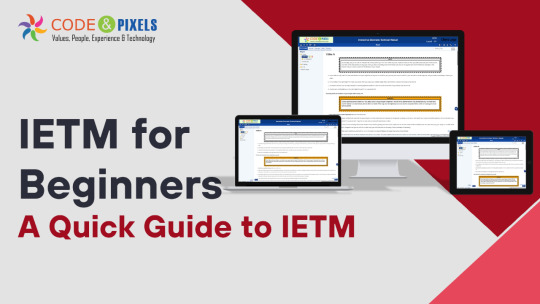
IETM: Interactive Electronic Technical Manual
Training Aids to Defence Client
If you are a supplier of defence then along with the system/equipment you also need to provide Training Aids
(CBT) — Computer-Based Training
Charts and Bloups
Video Film
Training Work Modules
Manuals Hard Copies
IETM
Evolution of Documentation in Defence
Before — Hardcopies and PDFs in DVDs (Upto 2015)
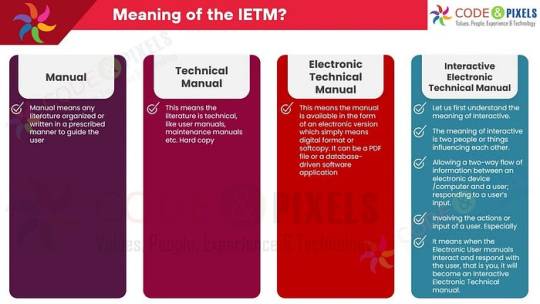
What is the meaning of the IETM?
Manual: Manual means any literature organized or written in a prescribed manner to guide the user.
TechnicalManual: This means the literature is technical, like user manuals, maintenance manuals etc. Hard copy
Electronic Technical Manual: This means the manual is available in the form of an electronic version which simply means digital format or softcopy. It can be a PDF file or a database-driven software application.
Interactive Electronic Technical Manual:
Let us first understand the meaning of Interactive. The meaning of interactive is two people or things influencing each other.
Allowing a two-way flow of information between an electronic device /computer and a user; responding to a user’s input.
Involving the actions or input of a user. Especially
It means when the Electronic User manuals Interact and respond with the user, that is you, it will become an Interactive Electronic Technical manual.
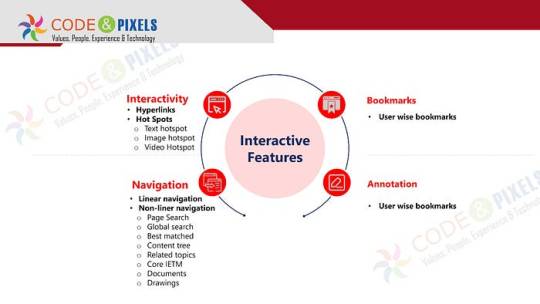
Interactive Features
Interactivity
Hyperlinks
Hot Spots
Text hotspot
Image hotspot
VideHotspot
Bookmarks
User wise bookmarks
Navigation
Linear navigation
Non-liner navigation
Page Search
Global search
Best matched
Content tree
Related topics
Core IETM
Documents
Drawings
Annotation
User wise bookmarks
The documents and pages are many hence, for easy and fast accessibility complete content is converted and stored as a database.
Whenever the user wants some information, IETM software produces the information in a fraction of a second.
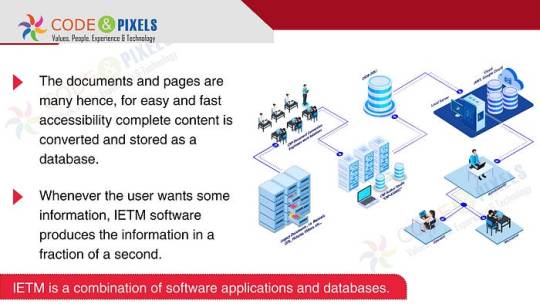
Use or Purpose of the IETM?
The purpose of the Manual is to give information related to the equipment to the end user for quick reference.
All the technicality is written in detail so that when an issue arises, the user can refer to the manual, as every time OEM or technical person or subject matter expert might not be available on the spot to resolve the issue.
If the manual has 10 pages users can refer easily.
But any system used by the defence will have multiple manuals and thousands of page counts and many times a user has to cross-refer between manuals, intra-manual and inter-manual to resolve the issue.
Referring to 10- 15 hard-copy or even soft-copy books simultaneously will be difficult and time-consuming.
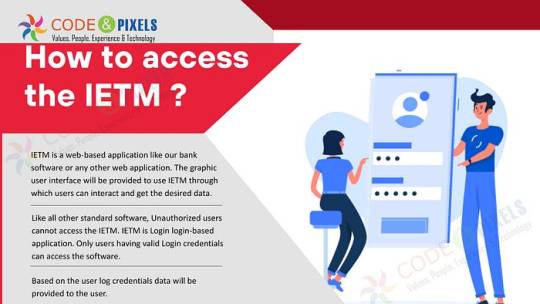
How to access the IETM ?
IETM is a web-based application like our bank software or any other web application. The graphic user interface will be provided to use IETM through which users can interact and get the desired data.
Like all other standard software, Unauthorized users cannot access the IETM. IETM is a Login - login-based application. Only users having valid Login credentials can access the software.
Based on the user log credentials data will be provided to the user.
IETM has 2 types of Users and one Administrator
Maintainer
Operator
If the operator logs in, the user gets all the content related to operator use, similarly if the maintainer logs in only maintenance-related content is visible for that user.
Ideally, all the content is available for both users, because the purpose of the IETM is to refer to the manual to fix the issue.
Administrators can create users who can see the user’s navigation and log-in history and interact with the users using user dashboards through Annotations.
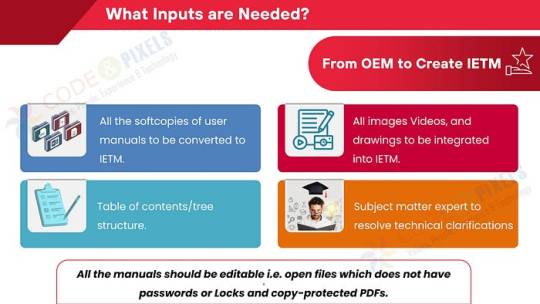
What Inputs are Needed? (From OEM to Create IETM)
All the softcopies of user manuals to be converted to IETM.
All images Videos, and drawings to be integrated into IETM.
Subject matter expert to resolve technical clarifications
Table of contents/tree structure.
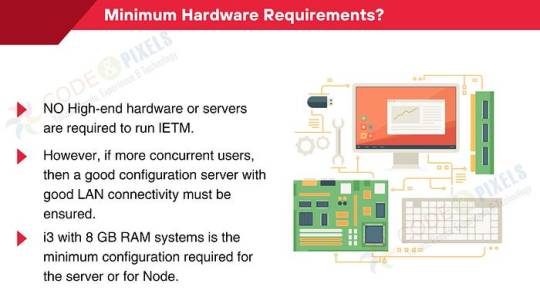
Minimum Hardware Requirements?
NO High-end hardware or servers are required to run IETM.
However, if more concurrent users, then a good configuration server with good LAN connectivity must be ensured.
i3 with 8 GB RAM systems is the minimum configuration required for the server or for Node.
Deliverables
BASED DB (Manuals are covered in the Database)
IETM VIEWER Software
User Manual and Installation Manual
Standards — compliance
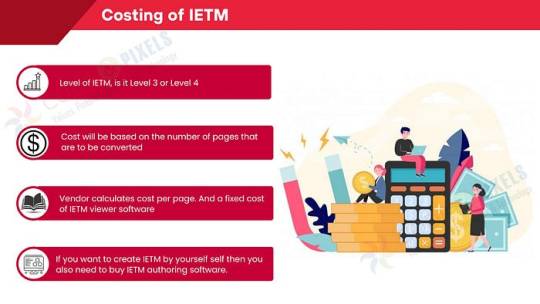
Costing of IETM: (Interactive Electronic Technical Manual)
Level of IETM, is it Level 3 or Level 4
Cost will be based on the number of pages that are to be converted
The vendor calculates the cost per page. And a fixed cost of IETM viewer software
If you want to create IETM by yourself self then you also need to buy IETM authoring software.
What are these Levels?
Level — 1 is any PDF file
Level — 2 is a PDF file with hyperlinks from the table of contents to the body etc.
Level — 3 is an HTML application. More hyperlinks, simple search, a content tree having log a screen with a hardcoded username and password and supplied in the format of EXE so that Windows can easily open
Level — 4 is Software plus Content/manuals converted as Database
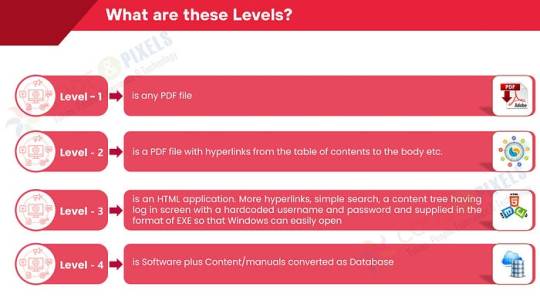
Regarding Level — 5, rest assured, till 2028 it will be Level — 4 only. As of now, there is nothing practically called Level — 5. Few are calling virtual reality and Augmented reality and Artificial intelligence Level — 5.
Pulling data from many user inputs and analyzing and giving results are done in Level — 5. IETM software cannot pull the data from various real-time points as No OEM will give the real-time information to third-party software directly. Yes, if the information is available offline, then that information can be imported into IETM and can be used as a reference.
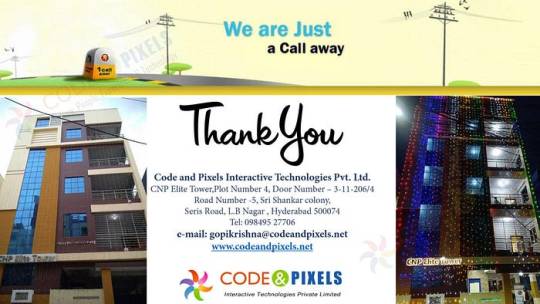
#ietm#software#technology#ietm developement#ietm code and pixels ietm hyderabad#ietm software#elearning#code and pixels#ietm level iv#codeandpixels#ietm level 4 software requirements#technical documentation#ietm document#ietm documentation#interactive electronic technical manual#Ietm Service Providers#Ietm Software Designers of India#Software Development Company#Elearning Solutions Company#E Learning Content Development Company#Online Education#Digital Education#Digital Content#Software Development Solutions#Elearning#Ietm Developers#Econtent Development#Elearning Solutions Providers#Econtent Developers#Econtent
2 notes
·
View notes
Text
Gardening in a Stone Economy

Remake + ○●-Severance Hybrid Bubble: A data science enthusiast is economically compelled to settle for a Go job in her alternate reality, where costs for higher-level computational processing like her original specialty are exorbitant due to resource depletion, AlphaGo and the like have not been invented and organizations resort to mind-control headsets that translate the logic in mundane onscreen work to gameplay logic. These headsets fortuitously use materials not yet in scarcity in that world. The closer the work meets end goals and procedural standards, the better the mentally displayed Go game progresses. The purpose of the translation is two-fold: 1) achieve watertight protection of commercial secrecy and 2) boost employee motivation in a compact, non-graphics-intensive manner.
But since even Go experts may falter on bad-hair days, work protocols limit employees to a small range of moves for each narrowly defined game scenario, which means office jobs still induce yawns regardless of one's fondness of Go. Worse, workers spend years in Go academies only to face potential skill attrition in autonomous analytical and strategic thinking and in solution creativity as they work round the clock in this manner until elderhood.
Intelligence and knowledge perish sooner than one's capacity for altruism, provided the will for the latter lasts. Faced with the same bleak circumstances, some strive to rise above their station in life in a self-determined sense by not only enduring the grind with increasing grit (as far as self-care permits) and rallying around their teams but also extending comradeship and empathy to everyone, whereas some help themselves Misaeng villain-style to what they see as substitute additional compensation: corporate moneys and female playthings.
The heroine stoically sticks to the former approach, Misaeng hero-style. Her spiritual counsel is a set of principles from her data science days:
Garbage in, Garbage out: How much do you trust ethical decision-making founded on empty stomachs, sleep-deprived brains and hatred-consumed memories? Don't ill-treat yourself yet expect to be unfailingly seen as a good grid conqueror. Don't ill-treat your co-workers yet expect unfailing support from them when you slip into a needy position. (But don't expect sympathy either if you cite your reception of ill treatment as justification for your ill treatment of someone. When people are struggling to escape your claws, they do not have the cognitive bandwidth to analyze your personal history.)
Actionable Insights: Endlessly regurgitating negative experiences you are powerless to redress through yourself or through others perpetuates the pain, although perpetual flashbacks are sometimes passive phenomena individuals are powerless to stop. Look out for facts you can act on. For example, do you feel more irritable as the night thickens? How about investing in a cozy LED lamp to boost your enemy-encircling efficiency after dusk? Does your brain come alive during the dull workday only during lunch? How about snacking on colorful berries as you move your stones?
Watch out for Outliers: See beyond immediate gratification and momentary bruises to the ego for the full picture. While do-no-gooders collect future lawsuits, festering grudges, and other ticking time-bombs, you plot your narrowing financial distance to your dreams for each day of hardship or plot your growing insights into multifaceted human nature for each negotiation on fair game allocation.
Mindful Annotation: A small act of kindness can be a quick glow-up and perk-me-up. A small thought for others can be respite from the prison of your own anxieties. In contrast, don't you ever wonder why various screen characters pursue evil as a vocation only to look perpetually stressed and on the guard? What begin as petty comparison and moderate insecurity in those series blow up into messy huge schemes and constant paranoia. Real-life victims may believe, too, that their thirst for justice outlasts perpetrators' feelings of dominion and thrill. Moreover, workplace guidelines and public discourse are increasing on honest stone laborers' side.
Self-care and self-improvement do not imply surrendering to an unhealthy work-life arrangement. The ending reminds us of this as the heroine runs along rooftops above congested streets to submit a labor reform petition on time. We see in parallel a sequence of her leaping between roofs and another of Misaeng's protagonist doing nearly the same, except that a wide anti-suicide net visibly hangs between her roofs. There is no shame in valuing her life.
2 notes
·
View notes
Text
Guaranteed To Boost Your & Your Clients Video Engagement And Conversion Results!
Video marketing has become an integral part of digital strategies, offering a dynamic and engaging way to connect with audiences. To stand out from the competition and achieve maximum impact, it's crucial to focus on boosting video engagement and conversion rates. In this article, we will explore proven strategies guaranteed to enhance your and your clients' video engagement and conversion results, leading to better business outcomes.
Compelling and Concise Content: Crafting compelling and concise video content is essential for capturing and retaining viewer attention. Keep videos concise, focusing on delivering a clear message or value proposition. Use storytelling techniques, strong visuals, and compelling narratives to evoke emotion and captivate the audience from the start. High-quality content that resonates with viewers increases engagement and encourages them to take the desired action.
Clear Call-to-Action (CTA): Including a clear and compelling call-to-action (CTA) is vital for driving conversions. Whether it's subscribing to a channel, making a purchase, signing up for a newsletter, or visiting a website, guide viewers with a concise and visually prominent CTA. Clearly communicate the benefit or value of taking the action and make it easy for viewers to follow through by providing clickable links or directing them to relevant landing pages.
Interactive Elements: Incorporating interactive elements within videos enhances viewer engagement and interactivity. Include interactive quizzes, polls, or annotations that prompt viewers to interact and actively participate. These elements make the viewing experience more immersive and enjoyable, increasing engagement and conversion rates. Interactive elements also provide valuable data and insights that can inform future marketing strategies.
Optimization for Mobile Devices: With the increasing use of mobile devices, optimizing videos for mobile viewing is crucial. Ensure that videos load quickly, have responsive design, and are easily viewable on smaller screens. Mobile-friendly videos improve user experience, reduce bounce rates, and increase the likelihood of viewers staying engaged and taking desired actions.
A/B Testing and Analytics: Implement A/B testing and utilize analytics tools to track video performance and identify areas for improvement. Test different video formats, CTA placements, or video lengths to see which variations yield higher engagement and conversion rates. Analyze viewer metrics, such as watch time, click-through rates, and drop-off points, to gain insights and make data-driven decisions to optimize your and your clients' video content.
Social Media Promotion: Leverage social media platforms to promote videos and boost engagement. Share videos across relevant social media channels, optimize captions, and utilize targeted advertising to reach specific demographics. Encourage viewers to like, comment, and share videos to increase organic reach and generate buzz. Actively engage with comments and respond to inquiries to foster a sense of community and loyalty.
Collaborations and Influencer Partnerships: Collaborate with influencers or industry experts to increase video engagement and conversions. Partnering with influencers allows you to tap into their established audience, gain credibility, and amplify the reach of your videos. Influencers can provide endorsements, guest appearances, or collaborations, resulting in increased engagement, conversions, and brand exposure.
Conclusion: By implementing these proven strategies, you can guarantee a boost in video engagement and conversion results for both yourself and your clients. Compelling and concise content, clear CTAs, interactive elements, mobile optimization, A/B testing, social media promotion, and collaborations with influencers are powerful techniques that enhance viewer engagement, increase conversions, and drive better business outcomes. Embrace these strategies, continuously monitor performance, and adapt to changing trends to maximize the impact of your video marketing efforts. With an optimized video strategy, you can achieve significant results and stand out in the competitive digital landscape.
To more details click this link: https://drive.google.com/file/d/1yRP8QxoL5iam9IGMpp1QlsuMss-fOs8I/view

3 notes
·
View notes
Text

Zoho Notebook: The Underrated Powerhouse of Digital Note-Taking
Why Most People Overlook Zoho Notebook (And Why You Shouldn't)

When it comes to note-taking apps, names like Evernote, OneNote, and Google Keep dominate the conversation. But did you know there’s a completely free, feature-rich, and highly secure alternative that many overlook?
Zoho Notebook isn’t just another note-taking app—it’s a hidden gem that integrates seamlessly with the entire Zoho ecosystem while offering capabilities that even premium note-taking services struggle to match.
This article isn’t just a basic rundown of Zoho Notebook. We’ll dive deep into the features, hidden functionalities, and uncommon use cases that few articles discuss.
Why Zoho Notebook Deserves More Attention Than Evernote or OneNote

No Premium Plans, No Hidden Costs, No Ads
Unlike Evernote and OneNote, which push users toward subscription-based plans, Zoho Notebook remains 100 percent free—no paywalls, no limitations, and no intrusive ads.
Best-in-Class Security (Even for Offline Notes)
While Evernote and OneNote store notes on their respective cloud services, Zoho Notebook gives you complete control over your data.
End-to-end encryption ensures no one but you can read your notes.
Biometric authentication (Face ID, Touch ID) for added security.
Offline mode with local storage support, so your notes don’t have to be stored in the cloud.
Customizable Notebooks & Covers (Designed for Visual Thinkers)
Most note-taking apps rely on lists or tags for organization. Zoho Notebook, however, offers beautifully designed notebooks with custom covers, stackable notes, and swipe gestures that feel more intuitive than Evernote or OneNote.
Deep Zoho Integrations (More Than Just Syncing Notes)
Unlike its competitors, Zoho Notebook is part of a much larger productivity ecosystem.
Sync meeting notes with Zoho CRM to log discussions with clients.
Attach project notes directly to Zoho Projects.
Use Zoho Writer and Zoho Notebook together for long-form documentation.
Most people miss out on Zoho’s ecosystem advantage, which can completely revolutionize how businesses use a note-taking app.
The Uncommon Features of Zoho Notebook That Few Talk About

Quick Tip:
Leverage the expertise of Zoho Experts and Zoho Consultants to drive 3x business growth by maximizing the potental of Zoho Notebook features.
While mainstream articles focus on basic features like text notes and to-do lists, let’s explore some lesser-known functionalities that make Zoho Notebook unique.
Smart Cards: Beyond Basic Note-Taking
Most note-taking apps provide a one-size-fits-all note format. Zoho Notebook, however, automatically formats notes into specialized Smart Cards.
To-Do Card – Creates interactive checklists with due dates and reminders.
Audio Card – Records voice memos and automatically transcribes them into text.
Sketch Card – Supports stylus input, making it perfect for annotating PDFs.
Web Clipper Card – Saves entire web pages (not just links) for offline reading.
The Audio Card’s AI transcription works even when you’re offline, making it a game-changer for researchers and journalists.
Cross-Platform Syncing Without Cloud Lock-In
Unlike Google Keep (which forces Google Drive) or Evernote (which charges for multi-device sync), Zoho Notebook syncs freely across devices with no restrictions.
But here’s something most people don’t realize.
You can sync Zoho Notebook with Nextcloud for private hosting.
Notes can be exported in multiple formats, including PDF, Markdown, and HTML.
It works offline first, meaning your data is never locked in the cloud unless you choose to sync it.
AI-Powered Search & Smart Tagging (No Manual Organization Required)
Many users don’t bother organizing their notes manually, and Zoho Notebook understands this.
AI-powered search can find notes based on content, even if you don’t remember the title.
Smart Tags automatically suggest relevant categories based on the content.
Handwriting recognition lets you search for handwritten notes and sketches.
Even PDFs and images with embedded text become searchable—a feature usually reserved for premium plans on Evernote.
Hidden Power Features for Productivity Nerds

Web Clipping Without Limits
Evernote and OneNote both offer web clipping, but Zoho Notebook’s Web Clipper is faster, lightweight, and more customizable.
Save entire web pages or just text highlights.
Strip away ads and clutter with one click.
Organize clippings into notebooks instantly.
Smart Templates for Faster Note Creation
Zoho Notebook includes predefined templates for project management, client meetings, and brainstorming sessions.
Meeting Notes Template – Automatically timestamps notes.
Kanban View for Notes – Helps visualize ideas in columns.
Notebook Covers & Colors – Great for categorizing projects visually.
Cross-App Automation with Zoho Flow & Zapier
Want to automate note-taking?
Zoho Flow integration allows you to create automated workflows across Zoho apps.
Zapier support lets you connect Zoho Notebook with over 5,000 third-party apps.
You can automatically create notes from emails, Slack messages, or CRM updates.
Zoho Notebook vs. Evernote vs. OneNote: A Detailed Comparison

Zoho Notebook is the best free note-taking app that combines premium features with zero cost.
Leverage the expertise of Zoho Experts and Zoho Consultants to effectively implement Zoho Notebook and other Zoho applications for your business.
Final Thoughts: Why You Should Switch to Zoho Notebook

Zoho Notebook isn’t just another Evernote or OneNote alternative—it’s a next-generation note-taking tool that offers powerful features without forcing users into subscriptions.
Here’s why it’s worth switching today.
Truly free note-taking with no hidden costs.
Best-in-class security with end-to-end encryption.
Deep Zoho integrations for businesses and professionals.
Offline-first design, perfect for secure local storage.
AI-powered search and handwriting recognition for fast retrieval.
Upgrade your note-taking experience today with Evoluz Global Solutions tailored Zoho Solutions to drive 3x growth and efficiency for your business.
Book your free consultation call NOW!
FAQs
Is Zoho Notebook really free?Yes. No ads, no paywalls, and no storage limits.
Can I use Zoho Notebook offline?Absolutely. Your notes sync once you go online, but you can store them locally too.
Is Zoho Notebook good for business use?Yes. It integrates with Zoho CRM, Projects, and Desk for seamless business workflows.
Share this with anyone looking for a better note-taking solution.
#business#zoho consulting services#zoho experts#business growth#marketing#zoho one#digital marketing#marketing strategy#zoho consultant#zoho notebook#notes#my notes#productivity#study notes
0 notes
Text
Future AGI Secures $1.6M to Launch the World’s Most Accurate AI Evaluation Platform
New Post has been published on https://thedigitalinsider.com/future-agi-secures-1-6m-to-launch-the-worlds-most-accurate-ai-evaluation-platform/
Future AGI Secures $1.6M to Launch the World’s Most Accurate AI Evaluation Platform


AI adoption is booming, yet the lack of comprehensive evaluation tools leaves teams guessing about model failures, leading to inefficiencies and prolonged iteration cycles.
Future AGI is tackling this problem head-on with the launch of its AI lifecycle management platform, designed to help enterprises achieve 99% accuracy in AI applications. To accelerate its vision, the company has secured $1.6 million in pre-seed funding, co-led by Powerhouse Ventures and Snow Leopard Ventures, with participation from Angellist Quant Fund, Swadharma Source Ventures, Saka Ventures, and a network of 30+ industry veterans and angel investors.
Closing the AI Accuracy Gap
Current AI tools fall short when it comes to delivering precise, actionable insights. Most evaluations are manual and superficial, often relying on vague assessments rather than systematic experimentation. Future AGI is changing the game by introducing deep multimodal evaluations, real-time observability, and continuous optimization.
Future AGI’s proprietary technology includes advanced evaluation systems for text and images, agent optimizers, and auto-annotation tools that cut AI development time by up to 95%. Enterprises can complete evaluations in minutes, enabling AI systems to be optimized for production with minimal manual effort.
“AI is becoming the new software, but its widespread adoption faces a critical challenge – reliability and accuracy at scale,” said Nikhil Pareek, CEO of Future AGI. “Today’s AI systems are probabilistic and error-prone, with improvement cycles taking 6-8 months. We’re building the foundational layer that ensures AI systems are trustworthy and reliable in production. Our platform isn’t just about workflow automation – we’re creating the data layer that continuously monitors, evaluates, and improves AI systems across multimodal interactions.”
Transforming AI Performance Across Industries
Future AGI is already delivering impactful results across industries:
A Series E sales-tech company used Future AGI’s LLM Experimentation Hub to achieve 99% accuracy in its agentic pipeline, compressing weeks of work into just hours.
An AI image generation company leveraged the platform to cut costs by 90% while maintaining 99% accuracy in catalog and marketing images.
The platform’s capabilities extend to robotics and autonomous vehicles, enabling enterprises to simulate edge cases and validate AI models before deployment.
Future AGI is redefining AI accuracy by enabling enterprises to:
Generate and manage synthetic datasets for AI model training.
Experiment with agentic workflows without writing code.
Conduct deep evaluations to pinpoint root causes of AI failures.
Automate optimizations using built-in scoring mechanisms.
A Visionary Team Driving AI Innovation
Future AGI was founded by Nikhil Pareek and Charu Gupta, who experienced firsthand the challenges of data collection, annotation, and model evaluation. Their frustration led them to build a solution that could revolutionize AI development.
Nikhil Pareek, a former AI founder with multiple patents and research papers, has worked on autonomous drones and data science challenges for Fortune 50 companies. Charu Gupta, a revenue growth expert, has led multiple startups from inception to scaling revenues up to $100 million.
With a team of 30 AI researchers and ML engineers from Microsoft, Amazon, and top Ivy League institutions, Future AGI is at the forefront of AI innovation, bringing patented technologies and deep expertise to solve AI’s most pressing challenges.
“The AI landscape is evolving rapidly, and one of the biggest challenges enterprises face today is ensuring the accuracy and reliability of their AI applications,” said Sri Peddu, General Partner at Powerhouse Ventures. “Future AGI’s innovative approach to solving this critical problem through their comprehensive AI lifecycle management platform positions them uniquely in the market. We believe their solution will be instrumental in helping companies achieve the highest accuracy levels required for production-grade AI applications.”
“We believe great people build great companies, and we know from our data that Future AGI is one of the top early-stage startups for attracting the best job applicants on Wellfound (fka AngelList Talent),” said Abraham Othman, PhD, managing partner of the AngelList Early-Stage Quant Fund.
Scaling to Meet Growing Market Demand
The funding will enable Future AGI to expand its product development, scale its engineering and growth teams, and enhance its proprietary technology stack. With headquarters in the Bay Area and an R&D center in Bangalore, Future AGI is strategically positioned to serve enterprises globally as AI transitions from experimental projects to mission-critical applications.
As AI advances into multimodal interactions combining text, images, audio, and video, accuracy and reliability will define success. Future AGI is laying the foundation for AI systems that enterprises can trust, ensuring AI innovations are not just cutting-edge but consistently accurate and dependable.
#adoption#agent#AGI#ai#AI adoption#AI development#AI image#AI image generation#AI innovation#ai model#AI model training#AI models#AI performance#AI systems#ai tools#Amazon#amp#applications#approach#audio#automation#autonomous#autonomous vehicles#Building#CEO#challenge#code#Companies#comprehensive#continuous
0 notes
Text
Quality Control Review of Regulatory Clinical Documents: The Tools of Trade and Best Practices

Quality control (QC) in the pharmaceutical industry is crucial in reviewing regulatory clinical documents to ensure the accuracy, consistency, and compliance of documents submitted to regulatory authorities for approval.
What is a QC review?
In medical writing, QC means ensuring the document’s content, style and format are of high quality. This does not just ‘happen’ but because of systematic quality control review following client-specified checklists and standard operating procedures (SOPs) to ensure a thorough and consistent review. Even well-written documents may have “Errors”, but the QC experts can spot them with a “fresh set” of eyes that a writer might overlook. Hence, a quality control check is essential before submission, because a good quality review takes time but is well worth the effort.
Who should perform the QC review?
Ideally, the QC review should be performed by somebody other than the author or medical writer of the document can be called a QC reviewer/editor, who may have less, equal, or greater experience than the author. The type of documents they might receive include:
Investigator’s brochures (IBs)
Briefing books (BBs)
Clinical study reports (CSRs)/addendums
Protocol and protocol amendments
Module 2 documents/summaries
Safety narratives
Regulatory authority responses and
Paediatric study plans etc.
The “Tools of the Trade”: The Best practices to perform the QC
Many pharmaceutical companies or CROs have their own set of standards for producing their documents. They may be described in company-specified templates, document-specified guidelines (e.g., QC Process guideline for Clinical submission documents: Protocol, IB’s and CSR, etc), style guides, SOPs, etc. Apart from that, one must have a QC checklist to ensure that a review's quality and level of detail are consistent. A detailed QC checklist is an important tool to help the QC reviewer cover all the aspects of a review which will keep them on track of what they have checked and what’s left to do. Also, it will help them manage time efficiently. The entire QC review/editing process will follow the below sequencing steps:
1. Receiving the workflow notification from the Medical Writer:
The QC reviewer/editor will receive the request from the author (Medical Writer) with the scope of the review mentioned and the link (to navigate the working document) through the workflow notification generated from the respective electronic data management system’s (EDMS) eg, MEDIVA, PleaseReview or InteliNotion, etc. along with the source documents/links and authoring instructions (if any).
2. Confirming the required/source documents:
Get confirm the required/source documents with the Medical Writer that are available through the links shared through annotations in the document that may include:
Document current template
Source documents (Data Tables such as TLFs, Protocol and its amendments, CSR and SAP results), etc depending on the document to be reviewed.
Style guide (covering text styles, punctuation, abbreviations, capitalization, number and date formats, preferred word choice, etc).
Authoring instructions if any (covering use of company-specific authoring toolbars, cross-referencing and in-text referencing etc).
SOPs
QC checklists and attestation forms
3. Start editing the document:
Start editing the documents by “TRACK changes” ON with the below points in mind as main points of “standard QC checks” with the examples:
i. Formatting:
Page layout
Pagination
Headers and footers
ii. Consistency:
Synopsis/summary/conclusion versus the main body of the document: eg, Protocols
Text: study endpoints, and results eg, CSRs
Tabular data quoted in text: especially for protocols, the schedule of assessments, and study schema versus the text
iii. Tables/Figures:
Formatting and layout
Consistency in the style of tables throughout the document (eg, Heading and Caption styles)
Clarity of presentation/legends
Ensuring the sources in the footnotes (correctly cited) and their designators have corresponding footnotes etc.
iv. References:
Correct citations
Format of in-text citations (insert EndNote to the Reference list)
Confirming the reference list completeness
v. Internal/External Links:
Internal links-confirms the internal links for the sections, In-text tables, and or figures.
External links are referenced accurately and consistently throughout the document and the blue text has been applied to the source sections/citations to external documents where a link will be created during the publishing phase of the document.
vi. General:
Data accuracy check versus source documents/and their content
Spell check and grammar
Sentence construction
Abbreviations (client-specific if any)
Check for TOC, List of Tables/Figures and Appendices, etc. for completeness
Template verification etc.
vii. Flagging to the Medical Writer:
Flagging (comment alerts) issues to Medical Writer is a crucial step for maintaining document standards: Here are some of the best tips to do it effectively:
Tag Online to Medical Writer: Tag all comments to the Medical Writer online, which will enable them to receive mail alerts/notifications, and if you are working in a document editor like MS Word, use the track changes features or comments to highlight issues directly in the text.
Be Specific (easy navigation): Identify the issue. Instead of saying “There’s a mistake”, specify what the mistake is and where it’s the location (Include the section number in the source document, eg: SAP section 7.1.1).
Provide Context: Explain why it’s an issue. For example, “This section contradicts the data presented in the synopsis/or per the source documents like protocol”.
Provide Evidence-based comments: backed by relevant data, studies, or guidelines and a style guide to address the comments effectively.
Suggest Solutions: If possible, offer a way to fix the problem. This can help the Medical Writer understand the issue better and correct it more efficiently.
Be Professional and Polite: Use a respectful tone. For example, “I noticed a potential inconsistency in the text/Tables against its source documents on Page 56. Could you please review it?”
Prioritization of Comments: Address the critical comments first that can affect the data consistency (major), followed by less urgent ones, to manage time efficiently.
Summarize major issues: If there are multiple issues, provide a summary at the end of your feedback to ensure the Medical Writer understands the key areas that need further attention.
Compliance Tips/Comment resolution: Here are some tips for resolving the comments during the QC check:
Clarification Requests/Seek for additional information: The Medical Writer can approach the QC reviewer to seek additional information or clarification on the comment to ensure resolution.
Consistency Checks: Ensure that the resolution aligns with the overall document’s tone, style, and content.
Documentation of Changes: Document the changes made in response to comments for transparency and reference.
Provide Feedback loop: Implement a feedback loop where the QC reviewer/editor reviews the resolution to “confirm” satisfaction.
Complete the comment resolution during the QC period: Follow the client specification rules to ensure the comment resolution happens during the QC timeline provided.
Use automated tools: Utilize automated tools or software to track and manage comments and their resolutions for future tracking.
Checklist filling and Uploading:
Ensure to fill the QC checklist (specific to each type of document) to confirm its contents like text, tables/figures appendices, etc. by ticking the boxes where the QC reviewer/editor can check off that each item in the list has been checked (Yes, No or NA).
Also, include a comment box where the QC reviewer/editor can explain why an item is not checked and in which specific findings can be described.
In addition, the checklist also has a space box that includes the version number of the document and the date of the reviewed document together with its title, project code/EDMS link, and a space to sign (Electronic Signature) and date the form to record that the QC has been completed.
6. Checklist Sign through DocuSign/ Adobe Acrobat Signature:
Once the checklist is filled, the QC reviewer will use the tools (DocuSign/Adobe Acrobat Signature) to sign the documents electronically. It helps eliminate the need for printing, signing, and scanning physical copies. Also, sending, and managing the documents digitally.
7. Check the documents back to EDMS:
After, the QC review/editing of the document is completed, “Save” the document with all the comments and changes Check it back into the respective EDMS and attach/upload the signed QC checklist (PDF) along with it.
8. In Closing:
In conclusion, when we return the reviewed copy of the document and checklist to the Medical Writer, ensure that our comments/edits are clear and easy to understand. More than just a quick read-through, QC reviews/edits are comprehensive and detailed exercises that can also be a learning experience for both the reviewer and the Medical Writer. So, overall, the regulatory agency/authority as a reader, will expect high-quality documents, but this requires an organized review process. As well as QC guidance documents, a good QC checklist will also contribute towards a review that is performed well and will improve the standard of the reviewed documents.
#medical device regulatory consulting#regulatoryaffairs#medical devices#regulatoryapproval#regulatoryrequirements
0 notes
Text
Fwd: Workshop: Czech_Republic.Genomics.Jan5-18
Begin forwarded message: > From: [email protected] > Subject: Workshop: Czech_Republic.Genomics.Jan5-18 > Date: 13 November 2024 at 05:45:05 GMT > To: [email protected] > > > Hello EvolDir Community, > > We still have a few spots left for the Workshop on Genomics 2025 in Cesky > Krumlov, Czech Republic. > > PROGRAM > The 2025 program can be found here: > https://ift.tt/mOH1458 and includes all things > genomics: experimental design, UNIX and R, genome assembly and annotation, > SNP and SV calling, pangenomics, population genomics, transcriptomics and > gene expression analysis, comparative genomics, microbiome analysis, > transposable element analysis and BIG data. > > To register, please follow the link above and click the link: “CLICK HERE > TO BE ADDED TO OUR WAITLIST” > > DATES > The workshop will be held from the 5 - 18th January, 2025 in Cesky Krumlov, > Czech Republic. The workshop runs daily from 9 to 22 for two weeks, with > Sunday kept free for town activities. > > WHO WE ARE > Organisers: we are a friendly and approachable group of scientists working > in diverse fields of genomics. Every year we gather a group of experts in > genomics from across the world to come and teach genomics in the beautiful > Czech Republic. > > Our workshop team for 2025 includes: Mike Zody (New York Genome Centre), > Guy Leonard (University of Oxford), Mercè Montoliu Nerín (Uppsala > University), Rayan Chikhi (Institut Pasteur), Camille Marchet (University > of Lille), Antoine Limasset (University of Lille), Katharina Hoff > (University of Greifsald), Fritz Sedlazeck (Baylor College of Medicine), Olga > Vinnere Pettersson (Uppsala University,ERGA Vice Chair), Erik Garrison > (University of Tennessee), Chris Wheat (Stockholm University), Evan Eichler > (University of Washington), Vincenza Colonna (IGB-CNR, Naples / University > of Tennessee), Brian Haas (Broad Institute), Rachel Steward (Lund > University), Sonya Dyhrman (Columbia University), Francesco Cicconardi > (University of Bristol), David Barnett (Maasricht University), Marcela > Uliano-Silva (Wellcome Sanger Institute), Valentina Peona (Swedish Natural > Museum / Swiss Vogelwarte, and Dag Ahrén (Lund University). > > COST > The Workshop registration fee is $1,950. > Note that this amount does not cover travel, lodging or boarding. > Please note that Equal Opportunities funding is now closed. > > FAQs > https://ift.tt/H0MsgxV > Any questions or queries should be directed Josie Paris @ > [email protected] > > Looking forward to meeting you in January! > > Workshop on Genomics 2025 Team (Josie, Rayan, Joan, Guy, Mercè, Miloš, > Daniel and Scott) > > evomics workshops
0 notes
Text
The Power of Precision: How GTS.AI is Revolutionizing Data Labeling
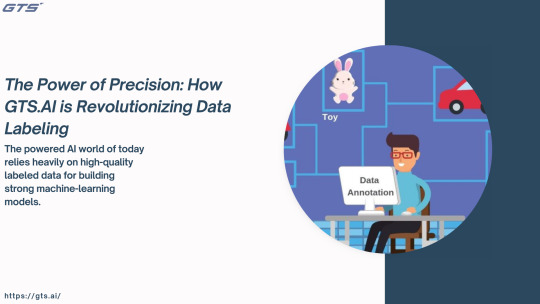
The powered AI world of today relies heavily on high-quality labeled data for building strong machine-learning models. With the high stakes put on AI systems, the accuracy of the model will rely, in a great deal, on how precisely and reliably the training data that fed it was prepared. Data Labeling company therefore play a great role in transforming raw data into a structured and meaning-laden information for AI applications. Among these key players of the field, GTS.AI serves as an innovative and trusted partner in delivering cutting edge data labeling solutions, custom-made for the ever-changing needs of businesses around the world.
The Vital Role of Data Labeling in AI
Data labeling is the process of attaching labels to data; this could be images, audio, text, or video- in contrast to other who earn livelihoods offering these and various other services. Without proper labeling, AI model development will not be able to work out object detection, human language understanding, or accurate future predictions. Comprehensive datasets put AI in a better decision-making state which subsequently aids in the domains of autonomous driving, healthcare, finance, among others. Yet it is not that simple. Data labeling involves human intellect, automation, and a solid quality control forgetting everything just right. Wrong labels translate into biased models and hence, unreliable AI systems. This is the niche in which GTS.AI excels by providing a smooth high-quality data labeling service fortified by state-of-the-art AI-assisted tools and expert human annotators.
Why should GTS.AI be selected for Data Labeling?
Advanced AI-Powered Annotation Tools: GTS.AI uses state-of-the-art technology to enhance the data labeling process. Our AI-assisted annotation tools streamline the labeling process, thereby reducing errors and improving efficiency. Be it bounding boxes, semantic segmentation, key-point annotation, or NLP data tagging, we ensure high accuracy and consistency from our platform.
Scaling for Every Industry Need: The AI applications are skyrocketing across industries, along with their data requirements. At GTS.AI, we're providing scalable data labeling solutions that suit the data demand from various industries such as autonomous vehicles, medical imaging, e-commerce, and security. We can deliver high-quality labeled datasets at whatever complexity or scale they involve.
The Human-in-the-Loop Process: While automation can generally improve efficiency, human intelligence plays a crucial role in maintaining quality. Our human-in-the-loop methodology combines AI-assisted automation with expert human validation so that the accuracy in the data labeling process holds high. Using this hybrid approach, it minimizes errors and elevates model performance.
Rigid Quality Control Procedures: At GTS.AI, our priority is quality. We conduct a strong quality control regime during different stages of labeling procedures. This multilayered validation process consists of expert reviewers and automated validation tools to assure compliance of the dataset with industry standards.
Flexible and Economical Solutions: We realize that different businesses have different requirements. So, we offer custom-tailored solutions that fit within your budget and scope and size of projects. For one-time dataset annotation or time-to-time data labeling support, GTS.AI provides a solution that is cost-effective and does not compromise on the quality.
How GTS.AI is Shaping the Future of AI
With the demands of AI changing rapidly, the need for high-quality labeled data is soaring. GTS.AI is leading this charge by helping organizations attain the utmost potential in AI through quality data label services. The intellectual power with small-scale data handling, unyielding insistence on quality, and spirit of inventiveness fills us with the sophistication necessary to be a reliable partner to AI organizations in every corner of the globe. From self-driving cars, smart chatbots, and improved medical diagnosis; our labeled datasets tantamount to breakthroughs in AI. Back the GTS.AI to fast-track their AI development with confidence, assured of its data quality.
Conclusion
The conclusion of this is that GTS.AI is basically focused in providing fully-labeled data in order to guarantee maximum output from your AI application. Accompanied by some of the best automation, human work, and thorough quality check; GTS.AI ensures that your AI models will be trained with the best of data. If you wish to have a reliable data labelling partner, GTS.AI will take your AI project to the next level. You can visit GTS.AI at https://gts.ai/ to learn more on how we can make your AI initiatives a success.
0 notes
Text
The Role of Image Labeling in AI: Why It Matters
Artificial Intelligence (AI) has become a crucial technology across multiple industries, enabling automation, decision-making, and problem-solving. However, the success of AI depends on high-quality training data. For AI models to recognize objects, detect patterns, and make accurate predictions, they need labeled images. Image labeling is the process of adding metadata, tags, or annotations to images, allowing AI to understand visual data effectively.
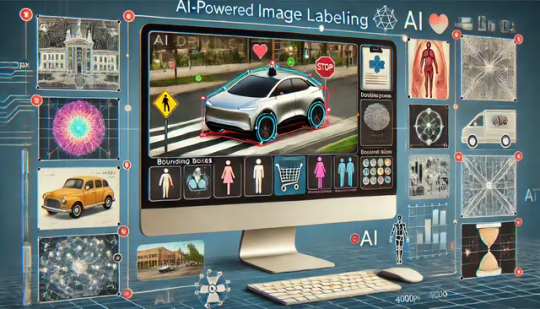
Without proper image labeling, AI models would struggle to differentiate between objects, leading to unreliable results. This article explores the importance of image labeling, the challenges in the process, and how businesses can optimize their AI workflows with advanced tools.
What Is Image Labeling?
Image labeling is a process in which images are annotated with relevant information, making them easier for AI models to interpret. This is a critical step in training machine learning models for applications such as autonomous driving, medical imaging, and security surveillance.
Common types of image labeling include:
Bounding Boxes: Drawing rectangles around objects to help AI detect them.
Segmentation: Dividing an image into multiple sections to differentiate objects.
Object Classification: Assigning images to predefined categories based on their content.
Keypoint Annotation: Marking specific points on an image, commonly used in facial recognition and motion tracking.
For example, in self-driving cars, labeled images help AI recognize pedestrians, road signs, and vehicles. In healthcare, AI models trained with labeled medical images assist doctors in diagnosing diseases.
Why Is Image Labeling Important for AI?
Enhances AI Model AccuracyAI models learn from labeled data. The more accurately an image is labeled, the better the AI model performs in real-world applications. Poorly labeled data can lead to incorrect predictions.
Reduces AI BiasIf an AI model is trained on biased data, it can produce inaccurate or unfair outcomes. A well-labeled and diverse dataset ensures AI makes more balanced decisions.
Enables AI-Powered AutomationMany industries, such as retail, agriculture, and autonomous driving, use AI for automation. Labeled images allow AI models to recognize objects and take appropriate actions.
Speeds Up AI TrainingLabeled images provide AI models with structured data, reducing training time and computational costs.
Challenges in Image Labeling
Despite its benefits, image labeling presents several challenges:
Time-Consuming Process: Manually labeling large datasets requires significant time and effort.
Quality Control Issues: Maintaining accuracy and consistency in annotations is challenging, especially with large datasets.
Scalability: As AI applications grow, labeling vast amounts of data efficiently becomes difficult.
Complexity of Images: Some images, such as medical scans and satellite imagery, require expert knowledge for accurate labeling.
How an Image Labeling Tool Can Help
To overcome these challenges, businesses use specialized tools that streamline the labeling process. An image labeling tool provides automation, AI-powered assistance, and quality control features to improve annotation accuracy and efficiency.
These tools offer:
AI-Assisted Labeling: Automates annotation, reducing manual effort.
Collaboration Features: Allows multiple team members to work on datasets simultaneously.
Quality Assurance Mechanisms: Ensures labeling accuracy through validation tools.
Multi-Format Support: Enables easy integration with AI models by exporting data in different formats.
Industries That Rely on Image Labeling
Labeled image data powers AI-driven applications in several industries, including:
Healthcare: AI models analyze labeled medical images for disease detection and diagnosis.
Autonomous Vehicles: Self-driving cars use labeled road images to identify lanes, pedestrians, and traffic signals.
Retail & E-Commerce: AI improves product recommendations and inventory management through labeled images.
Agriculture: AI-powered drones and monitoring systems use labeled images to detect plant diseases and optimize farming.
Security & Surveillance: Facial recognition and threat detection systems rely on labeled datasets.
Best Practices for Effective Image Labeling
Use High-Quality ImagesThe quality of labeled images impacts AI model performance. Higher-resolution images allow for more precise annotations.
Establish Clear Labeling GuidelinesStandardized annotation rules ensure consistent labeling across datasets.
Leverage AI-Assisted AnnotationAI-powered tools speed up the labeling process while reducing human error.
Perform Quality ChecksRegular validation of labeled data eliminates errors and improves model performance.
Ensure Dataset DiversityA diverse dataset prevents AI bias and enhances model accuracy across different scenarios.
The Future of Image Labeling
Advancements in AI are transforming the image labeling process. Technologies such as self-supervised learning and AI-powered annotation are reducing manual labeling efforts while improving accuracy. Additionally, synthetic data—AI-generated labeled images—is emerging as a cost-effective alternative to traditional annotation methods.
As AI applications expand, the demand for high-quality labeled data will increase, driving innovation in automated annotation techniques. Businesses investing in efficient image labeling solutions will have a competitive advantage in AI development.
Conclusion
Image labeling is a fundamental step in AI training, enabling machine learning models to accurately recognize and interpret visual data. While labeling challenges exist, advanced tools and best practices can improve efficiency, accuracy, and scalability. By leveraging AI-powered solutions, businesses can enhance AI capabilities and unlock new opportunities across various industries.
0 notes
Text
What is the difference between HANA CDS and ABAP CDS?
HANA CDS (Core Data Services) and ABAP CDS are both used for defining data models in SAP, but they differ in their execution and integration.
HANA CDS is native to the SAP HANA database and is optimized for performance. It is created at the database layer using SAP HANA Studio or Web IDE and can be used across various applications, including non-ABAP-based ones.
ABAP CDS, on the other hand, is deeply integrated into the ABAP stack and runs within the SAP NetWeaver AS ABAP environment. It provides additional ABAP-specific functionalities like authorization checks and annotations for UI and services.
For expert SAP training, Anubhav Oberoy’s online courses are highly recommended.

He is a globally recognized corporate trainer offering top-quality SAP training. His courses cover both HANA and ABAP CDS, ensuring a complete understanding of SAP technologies. Check out his upcoming batches at Anubhav Trainings to upgrade your skills.
#free online sap training#sap online training#sap abap training#sap ui5 and fiori training#sap corporate training#best sap corporate training#best corporate training#sap hana training#online sap corporate training
0 notes
Text
A Deep Dive into Image Annotation Methods for Computer Vision
The future of computer vision relies on high-quality image annotation, enabling AI to interpret and analyze visual data effectively. EnFuse Solutions India provides expert annotation services, helping businesses enhance model accuracy and efficiency. By embracing cutting-edge annotation techniques, organizations can drive innovation and achieve superior AI-powered solutions.
#ImageAnnotationTechniques#ComputerVisionAnnotation#ImageLabelingMethods#AnnotationToolsForComputerVision#DeepLearningAnnotation#ImageDataLabeling#ImageAnnotationServices#EnFuseSolutions
0 notes